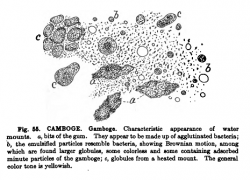Garcinia hanburyi (gum resin)
(Various title corrections, Source additions) |
(new template) |
||
| Line 14: | Line 14: | ||
=Botanical Voucher Specimen= | =Botanical Voucher Specimen= | ||
=Organoleptic Characteristics= | =Organoleptic Characteristics= | ||
| + | {| border=1 | ||
| + | | | ||
| + | {{Macroscopy | source=Schneider, A. (1921) The Microanalysis of Powdered Vegetable Drugs, 2nd ed. | ||
| + | | description= | ||
| + | | texture=Brittle, easily powdered. | ||
| + | | color=Bright yellow. | ||
| + | | flavor=Slightly acrid. | ||
| + | | scent=Nearly odorless. }} | ||
| + | |||
| + | {{Macroscopy | source=United States Dispensatory (1918) | ||
| + | | description=''Garcinia hanburyi'' (gum resin) is odorless; taste very acrid. [...] | ||
| + | It has no odor, and little taste, but, after remaining a short time in the mouth, produces an acrid sensation in the fauces.}} | ||
| + | |} | ||
=Macroscopic Characteristics= | =Macroscopic Characteristics= | ||
| + | {| border=1 | ||
| + | | | ||
{{Macroscopy | source=United States Dispensatory (1918) | {{Macroscopy | source=United States Dispensatory (1918) | ||
| − | | description= | + | | description=In hard, brittle, cylindrical pieces, usually hollow in the center, from 2 to 5 cm. in diameter, from 10 to 20 cm in length, externally grayish-orange-brown, longitudinally striate; fracture conchoidal, smooth, orange-red. |
| − | + | ||
| − | + | When rubbed with water it yields a yellow emulsion which becomes darker and almost transparent upon the addition of ammonia water. The emulsion turns green upon the addition of iodine T.S. (starch). | |
}} | }} | ||
| − | + | |} | |
=Microscopic Characteristics= | =Microscopic Characteristics= | ||
| + | {| border=1 | ||
| + | | | ||
{{Macroscopy | source=United States Dispensatory (1918) | {{Macroscopy | source=United States Dispensatory (1918) | ||
| description=The official description is [in part] as follows: | | description=The official description is [in part] as follows: | ||
| Line 30: | Line 46: | ||
{{Microscopy | source=Schneider, A. (1921) The Microanalysis of Powdered Vegetable Drugs, 2nd ed. | {{Microscopy | source=Schneider, A. (1921) The Microanalysis of Powdered Vegetable Drugs, 2nd ed. | ||
| − | |||
| − | |||
| − | |||
| − | |||
| − | |||
| − | |||
| characteristics=The microscope reveals little that is characteristic. Fragments of vegetable tissue are sparingly present. There is no starch present. The emulsified particles resemble bacteria and show active Brownian movement. | | characteristics=The microscope reveals little that is characteristic. Fragments of vegetable tissue are sparingly present. There is no starch present. The emulsified particles resemble bacteria and show active Brownian movement. | ||
| ash=Ash should not exceed 1.5 per cent. | | ash=Ash should not exceed 1.5 per cent. | ||
| Line 41: | Line 51: | ||
| }} | | }} | ||
| + | {{Media |cat=Microscopy | source=Schneider, A. (1921) The Microanalysis of Powdered Vegetable Drugs, 2nd ed. | ||
| + | | mainimage=Microanalysis_powdered_vegetable_p_257_google_ver_camboge_figure.PNG }} | ||
| + | |} | ||
=High Performance Thin Layer Chromatographic Identification= | =High Performance Thin Layer Chromatographic Identification= | ||
Revision as of 15:37, 18 March 2014
Contents |
Nomenclature
Garcinia hanburyi Hook. f. Clusiaceae
Syn. Hanbury's garcinia; Siam gamboge
Standardized common name (English): gamboge
Botanical Voucher Specimen
Organoleptic Characteristics
|
Macroscopic Characteristics
|
Microscopic Characteristics
|
High Performance Thin Layer Chromatographic Identification
Supplementary Information
Sources
- ↑ Schneider, A. (1921) The Microanalysis of Powdered Vegetable Drugs, 2nd ed.
- ↑ United States Dispensatory (1918)
- ↑ United States Dispensatory (1918)
- ↑ United States Dispensatory (1918)
- ↑ Schneider, A. (1921) The Microanalysis of Powdered Vegetable Drugs, 2nd ed.
- ↑ Schneider, A. (1921) The Microanalysis of Powdered Vegetable Drugs, 2nd ed.
